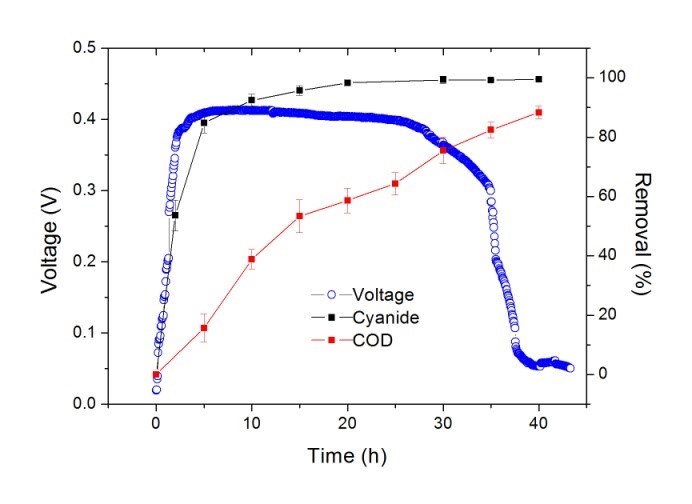Cyanide is commonly found as a contaminant in wastewaters from various industries including metal plating, electroplating, metal processing, steel tempering, ore leaching, photography, pesticide manufacturing, coal gasication, plastics, etc. Because cyanide is highly toxic to living organisms, cyanide-containing wastewater must be detoxied before discharging it into the environment. At present, cyanide-containing wastewater is mainly treated by chemical oxidation methods but these methods are expensive and cannot completely degrade cyanide. The use of biological processes for the treatment of industrial and hazardous liquid wastes were well established because biological treatment can provide a simple and cost effective solution to the treatment of liquid wastes, while providing high quality and environmentally acceptable effluents. Microbial fuel cell (MFC) technology holds promise for biological wastewater treatment because of its capability for simultaneous wastewater treatment and electrical energy production. The electricity-producing capacity of the electricigens declines for the biodegradation of cyanide-containing wastewater in MFCs because cyanide can strongly inhibit the activity and metabolism of most microorganisms. Therefore, if an electricity-producing and cyanidedegrading strain is screened, it will be of great signicance for the treatment of cyanide-containing wastewater. On the basis of such a background, Li Haoran’s group obtained an electrochemically active and cyanide-degrading strain from the deep-sea surface layer sediments, and the strain was identified as a strain of Klebsiella sp. Cyclic voltammetry showed that the strain MC-1 exhibited high electrochemical activity. The maximum voltage was 412 mV, and the chemical oxygen demand (COD) removal rate and cyanide degradation rate were 88.34% and 99.51%, respectively, when the MFC was fed with glucose–cyanide mixtures. The results demonstrated that the strain MC-1 was promising for the bioremediation of cyanide containing wastewater in MFCs. 
Fig.Cyclic voltammogram curves of the cell suspensions of Klebsiella sp. MC-1 and the fresh medium. 
Fig. 2 Comparison of voltage output with COD and cyanide removal using 500 mg/ L glucose and 30 mg/ L cyanide as the MFC fuel. This research was supported by China ocean mineral resources research program (no. DY125-15-T-08) and the National Natural Sciences Foundation of China (Grant no. 21176026; 21176242)and was published in RSC advances (2014, 4:36458-36463). (By Wang Wei-da,Tel:18810539349)
|